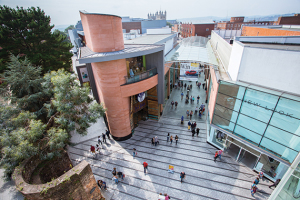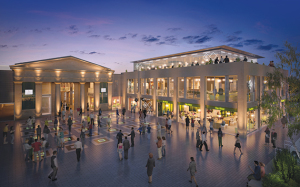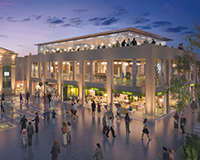 Exeter
Exeter
Exeter, already identified as one of the UK’s top 10 most profitable business locations, is also expected to be one of the main beneficiaries of a South West boom.
According to CBRE’s British Living report, the region’s economy is expected to grow by a “staggering 27%” over the next decade.
All of that will be music to the ears of the Princesshay Partnership, comprising the Crown Estate and TH Real Estate, which is unveiling its eagerly and long-awaited plans for a £70m leisure extension to its Princesshay shopping centre in Exeter (pictured).
Its plans, submitted to Exeter city council this summer, will see a 180,000 sq ft redevelopment of the city’s bus station into a mix of leisure and retail uses. The bus station, described by John Grinnell, development manager for the Princesshay Partnership, as “an eyesore which is divorced from the city centre” would instead become the venue for a new cinema and a blend of national, regional and local restaurants.
Princesshay Partnership hopes to gain outline consent by the end of the year, a landmark point in what it recognises as a long gestation period. A mix of prevailing national and local factors made it the right moment to bring the scheme forward, says Grinnell.
“Strong consumer confidence is underpinning sales nationally and that is good for the retail and leisure industries as a whole,” he says. “Plus, we are seeing operators consolidating their operations into the dominant centres.
“Exeter has a very strong local economy and, keeping an ear to the ground, we are hearing from retailers and leisure operators about their keenness to come into the city. But we are also hearing about the lack of space in terms of both quantity and quality.”
Princesshay Partnership has already taken steps to address the city’s lack of space. Within the existing Princesshay centre, it has been introducing new occupiers – a recent arrival being Jamie’s Italian. And at nearby Broadwalk House, which it also owns, it is applying to convert the ground floor of the office block into two restaurant units offering just over 6,000 sq ft.
 Princesshay is not the only Exeter stakeholder looking to capitalise on the growing popularity of the city’s hospitality sector. Across town, Aviva Investors is embarking on its £12m Queen Street dining development at the Guildhall shopping centre (pictured). Already lined up are Gourmet Burger Kitchen, Artigiano, Turtle Bay and The Stable.
Princesshay is not the only Exeter stakeholder looking to capitalise on the growing popularity of the city’s hospitality sector. Across town, Aviva Investors is embarking on its £12m Queen Street dining development at the Guildhall shopping centre (pictured). Already lined up are Gourmet Burger Kitchen, Artigiano, Turtle Bay and The Stable.
Simon Green, associate director for Aviva Investors, says operators expanding out of London were driving a lot of demand, but regional businesses were also proving to be “inquisitive.”
Plymouth
Plymouth is about a year away from seeing a start on site for a new £40m phase of the Drake Circus shopping centre and for the city’s foodies, that has the sweet smell of good news.
That is because the 100,000 sq ft scheme, being planned by British Land in collaboration with Plymouth city council, will involve the redevelopment of the city’s aged bus station into a new restaurant and leisure quarter.
A 12-screen Cineworld cinema will anchor a scheme that will deliver 13 new restaurants into a city centre market that has been woefully short of quality dining venues.
Extensive research among local shoppers has informed British Land about the pent-up demand for more catering. Matthew Reed, head of retail assets for the Midlands and South West at British Land, says average A3 spend per head is just £9, which is “fairly low” for a shopping centre of its size.
However, Plymouth’s potential catchment spend is a handsome £103m according to CACI and that, says Reed, “is what we are going for”.
The reason for the A3 famine lies in the geography of Plymouth’s tourist areas, many of which, such as Plymouth Hoe and the Barbican, lie outside the city core. So while the likes of Gary Rhodes can be found at The Dome on Plymouth Hoe and Hugh Fearnley-Whittingstall has his River Cottage Canteen at Royal William Yard, the city centre has remained virtually bereft of restaurants.
Now British Land is under offer with seven operators for units ranging from 1,500 sq ft to 5,000 sq ft and is promising what it describes as a “bedrock” of national names. It is also in discussions with London-centric restaurants about the possibility of taking their first operations outside the capital.
“We have been quite lucky in terms of timing,” says Reed. “Many are keen to acquire outside London. Also, Plymouth is seen as an exciting opportunity.”
The new phase of Drake Circus will also reflect a departure from the ‘box’ style of development that preceded it. It will instead be based on a contemporary streetscape format, with public realm and outdoor seating to flow nearby Exeter Street into the new scheme.
Also, to capitalise on a steep gradient from Exeter Street and the Bretonside bus station area down towards Plymouth marina, British Land plans a sky bar at the top of the development that will give coastal views.
“In every development we do, you see an evolution in the design process,” says Reed. “This leisure development will create better links through the shopping centre and into the Barbican area.”
Exeter offices
EG SW Exeter & Plymouth
The buoyancy of Exeter’s retail and leisure markets is in stark contrast to the challenges facing the city centre’s office market, where a profound shortage of supply is causing increasing concern and frustration.
As well as a lack of new development – held back by rental values that make it still not financially viable – increasing amounts of stock have been converted to other uses, particularly residential under PDR, but also for educational uses and student accommodation.
JLL director Andrew Pearce says: “It’s been taken out, rather than taken up.”
About 50,000 sq ft has been removed from the supply chain over the past two years and less than 10% of city centre supply is now available. Yet there remains an extant level of demand, with JLL analysis identifying 400,000 sq ft of enquiries since early 2014, each for more than 15,000 sq ft.
“But there are very few buildings that can satisfy requirements at that level,” says Pearce.
Mike Oldrieve, consultant with Vickery Holman, says: “For a vibrant, go-ahead economy, you need to have choice. If occupiers come to me looking for 5,000-10,000 sq ft, then it would be a struggle – and that’s frustrating.”
There are more opportunities out of town, where public-sector investment through the Regional Growth Fund or LEP funding has helped infrastructure for the likes of Skypark, Exeter Science Park and Cranbrook new town.
In the city centre, the local authority is said to be keen to protect office sites and agents cite overriding leases and council-owned sites being put into the equation to stimulate activity as possible ways forward. But as JLL’s Pearce stresses, viability is still the key.
Plans are being nurtured for a six-acre car park at Exeter St David’s station, which may bring some salvation.
Plymouth offices
While the city centre leisure market awaits what is seen as an obvious fillip from Drake Circus when it opens in 2018, Plymouth’s office market remains beleaguered. Like Exeter, it has its own surfeit of older space, but unlike Exeter, this is not being used for residential conversions to the same degree.
Design complications make many available buildings unsuitable for residential redevelopment, with floor-to-ceiling heights that are too deep and values that do not stack up.
Both scenarios bring their own headaches, of course. While the Exeter market worries about losing space to residential conversions, Plymouth frets about a city centre landscape scarred by obsolete, vacant office blocks. Agents say a clear planning strategy is needed to ensure such space is redeveloped in a way that benefits the city.
“The council needs a comprehensive planning brief to encourage developers,” says Tim Western, director of JLL.
He thinks the council has a role to play through CPO and acquisition processes, and it has already been proactive. Bringing forward a first phase of the Marine Industries Production Campus at South Yard, the council has been not just an enabler, but a creator of product, says Western. And at its Langage Science Park, 31,000 sq ft of new space was prelet to a food firm new to the region.
Mark Brunsdon, head of strategic development projects at Plymouth city council, says the council’s generic policy is to protect and retain employment land and uses, but change-of use applications are considered on their merits.
By next year, the city council will also have completed its strategic masterplan to steer development through to 2020. It will identify opportunities to attract new investment and provide new office and residential development, says Brunsdon.
The masterplan is focused on two key projects. A development site at the railway station, where the council would partner Plymouth University, Network Rail and First Great Western, could move forward by 2016, while land to the west of the city centre is earmarked for mixed-use, residential-led development.
The council recognises that Plymouth’s best office stock is at the waterfront, while much of the city core supply is in poorer condition. It thinks there is scope for a new office quarter, says Brunsdon.
Such a quarter could even be kick-started by the council itself as it reviews its own requirements for a minimum of 32,000 sq ft of new office space.











